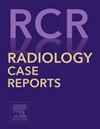Recurrent pineal tumor in a young adult male: Challenges in diagnosis and multimodal treatment management
Q4 Medicine
引用次数: 0
Abstract
Pineoblastomas are rare, severe primary brain tumors originating in the pineal gland. They might be challenging to detect and cure. This article recounts the example of a 23-year-old man who suffered from regular headaches and visual issues. During the first MRI, a solid cystic tumor in the pineal area was identified, creating obstructive hydrocephalus by squeezing surrounding brain regions. A low-grade glial tumor was discovered during the operation, which included partial tumor excision and an endoscopic third ventriculostomy. However, follow up imaging revealed a rapid recurrence requiring external ventricular drainage and a second craniotomy. Following the second surgery, histopathology confirmed pineoblastoma, demonstrating the aggressive character of the tumor. Postoperative imaging showed persistent illness despite these measures, requiring the implementation of a comprehensive treatment strategy. The multidisciplinary team suggested craniospinal irradiation (35 Gy in 21 fractions) followed by lesion boost (19.8 Gy in 11 fractions), using VMAT (Volumetric modulated Arc therapy) technique, along with concurrent chemotherapy followed by adjuvant chemotherapy. This case illustrates the difficulties in identifying and managing recurrent pineal tumors, including the need for appropriate adjuvant treatment, surgical constraints, and recurrence concerns. It provides crucial information regarding the challenges of treating aggressive brain tumors and emphasizes the need for interdisciplinary care to achieve the best results. This is a rare case of Central Nervous system recurrent tumor, which was earlier thought to be a low grade pineal tumor but later turns out to be high grade, Pineoblastoma in a young adult male. The case emphasizes the challenges in correct diagnosis of CNS tumors, importance of Immunohistochemistry and prompt management for complete cure of the disease.
年轻成年男性复发性松果体肿瘤:诊断和多模式治疗管理的挑战
松果体母细胞瘤是一种罕见、严重的原发性脑肿瘤,起源于松果体。它们可能很难被发现和治愈。这篇文章讲述了一个23岁的男人的例子,他经常头痛和视力问题。在第一次MRI检查中,在松果体区发现了一个实性囊性肿瘤,通过挤压周围的大脑区域造成阻塞性脑积水。在手术中发现了一个低级别胶质肿瘤,包括部分肿瘤切除和内镜下第三脑室造口术。然而,随访影像显示复发迅速,需要外脑室引流和第二次开颅手术。第二次手术后,组织病理学证实为松果体母细胞瘤,显示肿瘤的侵袭性。尽管采取了这些措施,术后影像学仍显示疾病持续存在,需要实施综合治疗策略。多学科团队建议颅脊髓照射(35 Gy / 21次),然后病变增强(19.8 Gy / 11次),使用VMAT(体积调制弧线治疗)技术,同时化疗,然后辅助化疗。这个病例说明了识别和处理复发性松果体肿瘤的困难,包括需要适当的辅助治疗,手术限制和复发问题。它提供了关于治疗侵袭性脑肿瘤的挑战的重要信息,并强调了跨学科治疗以达到最佳效果的必要性。这是一例罕见的中枢神经系统复发性肿瘤,早期被认为是低级别的松果体肿瘤,但后来发现是高级别的松果体母细胞瘤。该病例强调了正确诊断中枢神经系统肿瘤的挑战,免疫组织化学和及时治疗对疾病完全治愈的重要性。
本文章由计算机程序翻译,如有差异,请以英文原文为准。
求助全文
约1分钟内获得全文
求助全文
来源期刊

Radiology Case Reports
Medicine-Radiology, Nuclear Medicine and Imaging
CiteScore
1.10
自引率
0.00%
发文量
1074
审稿时长
30 days
期刊介绍:
The content of this journal is exclusively case reports that feature diagnostic imaging. Categories in which case reports can be placed include the musculoskeletal system, spine, central nervous system, head and neck, cardiovascular, chest, gastrointestinal, genitourinary, multisystem, pediatric, emergency, women''s imaging, oncologic, normal variants, medical devices, foreign bodies, interventional radiology, nuclear medicine, molecular imaging, ultrasonography, imaging artifacts, forensic, anthropological, and medical-legal. Articles must be well-documented and include a review of the appropriate literature.
 求助内容:
求助内容: 应助结果提醒方式:
应助结果提醒方式:


